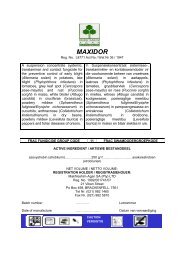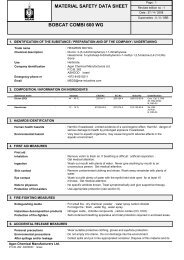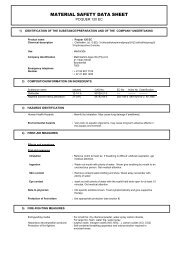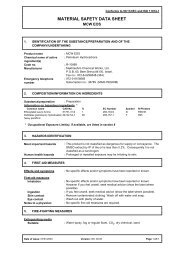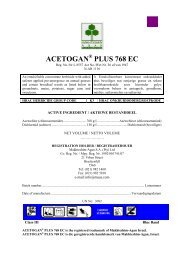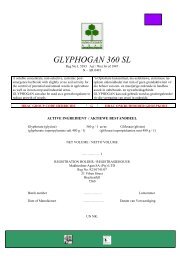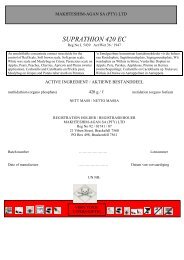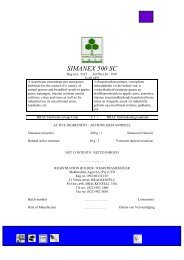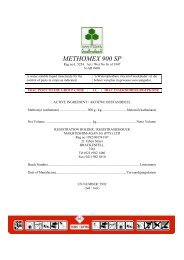VEZIR 240 SL - Makhteshim-Agan SA (Pty) Ltd
VEZIR 240 SL - Makhteshim-Agan SA (Pty) Ltd
VEZIR 240 SL - Makhteshim-Agan SA (Pty) Ltd
Create successful ePaper yourself
Turn your PDF publications into a flip-book with our unique Google optimized e-Paper software.
<strong>VEZIR</strong> ® <strong>240</strong> <strong>SL</strong>Reg. No. L 8406 Act / Wet No. 36 /1947A water soluble herbicide for the control ofannual broadleaf weeds, as listed below, in drybeans, soyabeans, and groundnuts.‘n Vloeistofkonsentraatonkruiddoder vir die beheervan eenjarige breëblaronkruide soos hieronderaangedui in droëbone, sojabone en grondbone.HRAC GROUP CODE HERBICIDE B HRAC GROEPKODE ONKRUIDDODERACTIVE INGREDIENT / AKTIEWE BESTANDDEELImazethapyr (imidazolinone) ............................<strong>240</strong> g / l .............................. Imasetapir (imidasolinoon)NET MASS / NETTO MAS<strong>SA</strong>…………… lREGISTRATION HOLDER / REGISTRASIEHOUERMAKHTESHIM-AGAN <strong>SA</strong> (PTY) LTDCo. Reg. No. 1992/001741/0721 Viben StreetBRACKENFELL7561Tel (021) 982 1460Fax (021) 982 5810Batch number ..……………. LotnommerDate of Manufacture ..……………. Datum van Vervaardiging<strong>VEZIR</strong> ® <strong>240</strong> <strong>SL</strong> is the registered trademark of <strong>Makhteshim</strong>-<strong>Agan</strong> Israel.<strong>VEZIR</strong> ® <strong>240</strong> <strong>SL</strong> is die geregistreerde handelsmerk van <strong>Makhteshim</strong>-<strong>Agan</strong>, Israel.UN NUMBER: 3082CAUTIONVERSIGTIG
WARNINGS:Withholding periods (minimum number of days between last application and harvest or feeding):All crops...........................................................................................................................................85 days• Handle with care.• Harmful if swallowed.• May irritate the eyes and skin.• Toxic to aquatic organisms.• Store in a cool dry place away from food, feed, fertilizer and other agricultural products.• Keep out of reach of children, uninformed persons and animals.• Aerial application: Notify all the inhabitants in the immediate vicinity of the area to besprayed and issue the necessary warnings. Do not spray over or allow drift to contaminateadjacent areas, water or any other area that is not under treatment.Although this remedy has been extensively tested under a variety of conditions the registrationholder does not warrant that it will be effective under all conditions. The activity and efficacy ofthe product may be affected by factors such as abnormal climatic and storage conditions, qualityof dilution water, compatibility with other substances not indicated on the label and theoccurrence of resistance of the weeds against the remedy, as well as by the method, time andaccuracy of application. The registration holder furthermore does not accept responsibility fordamage to crops, vegetation, the environment or harm to man or animal, or for lack ofperformance of the remedy concerned due to the failure of the user to follow the labelinstructions, or to the occurrence of conditions which could not have been foreseen in terms of theregistration. Consult the supplier in the event of any uncertainty.PRECAUTIONS:• Do not inhale fumes or spray mist.• Wash with soap and water after use or after accidental skin contact.• Do not eat, drink or smoke while mixing or applying or before hands and face are washed.• Prevent contamination of food, feed, drinking water and eating utensils.• Avoid drift of spray to other crops, grazing, rivers, dams or any other area that is not undertreatment.• RINSING OF CONTAINER - TRIPLE RINSE: Invert the empty container over the spray ormixing tank and allow to drain for at least 30 seconds after the flow has slowed down to a drip.Thereafter rinse the container three times with a volume of water equal to a minimum of 10 %of that of the container. Add the rinsings to the contents of the spray tank before destroying thecontainer by perforation and flattening. Never re-use the container for any other purpose.• Clean the applicator after use. Dispose of the rinsate where it will not contaminate crops,grazing, rivers, dams and boreholes.RESISTANCE WARNING:<strong>VEZIR</strong> ® <strong>240</strong> <strong>SL</strong> is classified as a Group Code B Herbicide. Any weed population may containindividuals which are naturally resistant to <strong>VEZIR</strong> ® <strong>240</strong> <strong>SL</strong> and other Group Code B herbicides. Theresistant individuals can eventually dominate the weed population if these herbicides are usedcontinuously and exclusively. These resistant weeds may not be controlled by <strong>VEZIR</strong> ® <strong>240</strong> <strong>SL</strong> or anyGroup Code B herbicide.To delay resistance the following can be done:• Avoid exclusive repeated use of herbicides from the same herbicide group code. Alternate ortank mix with registered products from different herbicide group codes.
• Integrate other control methods (chemical, cultural, biological) into weed control programmesFor specific information on resistance management contact the registration holder of this product.USE RESTRICTIONS:General:• Do not apply the post-emergence treatment of <strong>VEZIR</strong> ® <strong>240</strong> <strong>SL</strong> to PAN 717 soyabeans.• Only apply <strong>VEZIR</strong> ® <strong>240</strong> <strong>SL</strong> to Helderberg, Kamberg, Kranskop, PAN 148, Sabie and Teebusdry bean cultivars.• Do not apply <strong>VEZIR</strong> ® <strong>240</strong> <strong>SL</strong> post-emergence to plants stressed in any way, e.g. by factorssuch as drought, disease, nutritional deficiencies, nematode infestations or prior use of otherherbicides.• <strong>VEZIR</strong> ® <strong>240</strong> <strong>SL</strong> can be applied post-emergence to a crop at any time after the full emergenceof the third trifoliate leaf and before flowering.• If it is necessary to aerate the soil by cultivation before the post-emergence application is made,<strong>VEZIR</strong> ® <strong>240</strong> <strong>SL</strong> can be applied immediately after the cultivation or up to 14 days later,provided that the crop has not started flowering. If necessary, further shallow cultivations maybe carried out.• Do not apply post-emergence on soils with less than 15% clay.• Do not use <strong>VEZIR</strong> ® <strong>240</strong> <strong>SL</strong> on acidic soils with a pH below 5 ((KCl).• Do not apply more than 300ml/ha <strong>VEZIR</strong> ® <strong>240</strong> <strong>SL</strong> on a particular field per season.Waiting Periods for Follow-On Crops: (from after the last application to before the planting of thefollow-on crop)Dry beans, soyabeans and groundnuts.......................................................................................... NoneWheat...................................................................................................................................... 6 monthsAny other legume (other than dry beans, soyabeans and groundnuts)................................. 10 monthsMaize.................................................................................................................................... 20 months(Depending on the following factors, however,the waiting period may be shorter:• Soil type• Rainfall / irrigation• Application rate• Maize variety (please see end of label)Contact the supplier for further information.)All other crops (including popcorn and sweetcorn) ............................................................. 24 months• The waiting periods indicated above should be strictly adhered to in order to avoid thepossibility of damage to follow-on crops.• These waiting periods are only valid if the recommended application rates described in thislabel are used.• It is also necessary that a minimum of 350mm of rainfall and/or irrigation occur and, occurspecifically, after the application of <strong>VEZIR</strong> ® <strong>240</strong> <strong>SL</strong> and prior to the planting of the follow-oncrop.• These waiting periods will increase by an extra 12 months to a minimum of 20 months if thehigher rate of 190 – 210 ml / ha has been used to control Tribulus terrestris,• Land should always be well ploughed before planting a follow-on crop, and test planting ishighly recommended.
DIRECTIONS FOR USE:Use only as directed.General:• <strong>VEZIR</strong> ® <strong>240</strong> <strong>SL</strong> can be used either pre- or post-emergence of weeds and crop, as well as incombination as a pre-emergence application with a post-emergence follow-on spray.• Ideally 10 mm of rain should fall within seven days of a pre-emergence application in order for the<strong>VEZIR</strong> ® <strong>240</strong> <strong>SL</strong> to leach into the top layer of soil where it can be absorbed by the roots ofgerminating weeds.• If rain does not fall within seven days of an application, weeds may not come into contact with the<strong>VEZIR</strong> ® <strong>240</strong> <strong>SL</strong> or absorb it. In such a scenario, carry out a shallow cultivation / surface blend (3– 5cm) to control the weeds and also to incorporate the <strong>VEZIR</strong> ® <strong>240</strong> <strong>SL</strong> into the top layer of soil.• If heavy rains (> 15 mm / hour) fall within a few hours of a <strong>VEZIR</strong> ® <strong>240</strong> <strong>SL</strong> application, the postemergenceefficacy may be reduced. A similary shallow cultivation can be carried out under theseconditions. The residual efficacy of <strong>VEZIR</strong> ® <strong>240</strong> <strong>SL</strong> should not be influenced.• If heavy rains fall on sandy soils within a few days of a pre-emergence application, poor weedcontrol may result due to the movement of the <strong>VEZIR</strong> ® <strong>240</strong> <strong>SL</strong> out of the relevant area altogether.• In the case where heavy rains fall soon after a post-emergence application of <strong>VEZIR</strong> ® <strong>240</strong> <strong>SL</strong>,inter-node shortening and/or temporary yellowing of the crop may occur. Stressful environmentalconditions can exacerbate these effects, however, normal growth and appearance should resumewithin 1 - 2 weeks. Yield should not be adversely affected in anyway.• After a pre-emergence application of <strong>VEZIR</strong> ® <strong>240</strong> <strong>SL</strong>, weeds still germinate but soon succumb andstop growing. After a post-emergence application, susceptible weeds stop growing within 2 - 3days. Over the next 10 – 14 days they begin yellowing and after 3 - 5 weeks they either die orsimply no longer compete with the crop.• The control of late season weeds may appear to be unacceptable in treated areas of exceptionallyhigh weed density. Due to the thick weed and crop canopy, sufficient herbicide cannot reach thesoil for residual control. In cases such as these, ensure thorough coverage and wetting of theweeds.• A shallow surface blend or inter-row cultivation (
It is important that the spray mixture be kept in suspension during the mixing and application processesby thorough and continuous agitation. Do not leave the spray mixture in the spray tank for any length oftime e.g. overnight.If the water has a pH > 8, it is recommended that you use a buffering agent.APPLICATION:Ground application:<strong>VEZIR</strong> ® <strong>240</strong> <strong>SL</strong> can be applied by means of any suitable medium to high volume applicator, providedthat it is fitted with an efficient agitation system, it is able to apply the spray mixture evenly over thetarget area and it is calibrated correctly. Ensure thorough coverage of the target area by using not lessthan 200 l spray mixture per ha.Aerial application:Aerial application of <strong>VEZIR</strong> ® <strong>240</strong> <strong>SL</strong> may only be done by a registered Aerial Application Operatorusing a correctly calibrated registered aircraft according to the instructions of <strong>SA</strong>NS Code 10118 (AerialApplication of Agricultural Pesticides). Ensure that the spray mixture is distributed evenly over thetarget area and that the loss of spray material during application is restricted to a minimum. It istherefore essential that the following criteria be met:• Volume: A minimum spray volume of 30 l per ha is recommended. As the product has notbeen evaluated at a reduced volume rate the registration holder can not guarantee efficacy, or beheld responsible for any adverse effects if this product is applied aerially at a lower volume ratethan recommended• Droplet coverage: 20 - 30 droplets per cm 2 must be recovered at the target area for preemergenceand 35 – 45 for post-emergence.• Droplet size: A droplet with a VMD of 350 – 400 micron is recommended for pre-emergenceand 300 – 350 micron for post-emergence. Limit the production of fine droplets less than 150microns (high drift and evaporation potential) to a minimum.• Flying height: Maintain the height of the spray boom 3 – 4 metres above the target. Do notspray when the aircraft dives, banks or is in a climb.• Use suitable atomising equipment that will produce the desired droplet size and coverage, butwhich will ensure the minimum loss of product. The spraying system must produce a dropletspectrum with the lowest Relative Span.• Position all atomisers within the inner 60 – 75 % of the wing span to prevent droplets fromentering the wingtip vortices• The differences in temperature between the wet and dry bulb thermometers of a whirlinghygrometer should not exceed 8°C• Stop spraying if the wind speed exceeds 15 km / h• Stop spraying under turbulent unstable and dry conditions during the heat of the day• Spraying under temperature inversion conditions (spraying in or above the inversion layer)and / or high humidity conditions (relative humidity 80 % and above) may lead to the following:a) Reduced efficacy due to suspension and evaporation of small droplets in the air (inadequatecoverage)b) Damage to other sensitive crops and / or non-target areas through drifting of the suspendedspray cloud away from the target field.• Ensure that the Aerial Spray Operator knows exactly which fields to spray• Obtain an assurance from the Aerial Spray Operator that the above requirements will be met andthat relevant data will be compiled in a logbook and kept for future reference.
APPLICATION RATES:CROP &TREATMENTCLAY%DO<strong>SA</strong>GE RATE/ HAREMARKSDRY BEANSPhaseolus vulgarisand P. coccineusSingle preemergenceapplication0 – 1516 – 2526 – 30*125 ml170 ml210 ml*Unless a postemergencefollow-ontreatment is intended asper below, in which caseapply only170 mlApply <strong>VEZIR</strong> ® <strong>240</strong> <strong>SL</strong> pre-emergence (to crop andweeds) onto a well-prepared seedbed that is fine,even and firm and without excessive plant rests.Ground application:Apply by means of a suitable medium or highvolume applicator in at least 200 l of water / ha atplanting or within 3 days of planting.<strong>VEZIR</strong> ® <strong>240</strong> <strong>SL</strong> can also be mixed with aregistered pre-emergence grass herbicide at itsregistered rate for increased control of grasses.DRY BEANSPhaseolus vulgarisand P. coccineusPre-emergencefollowed by postemergenceapplicationGROUNDNUTSSingle preemergenceapplication0 – 1516 – 2526 – 300 – 1516 – 2526 – 30A follow-on applicationis not recommended onthis soil type. Applyonly pre-emergence asabove.170 ml (pre-emergence)followed by 125 ml+2% ammonium sulphatesolution+500 ml EOS / 100 lwater170 ml (pre-emergence)followed by 125 ml+2% ammonium sulphatesolution+500 ml EOS / 100 lwater125 ml170 ml210 mlAerial application:Apply as for Ground application above in at least35 l water / ha.A follow-on post-emergence treatment can beapplied in addition to the pre-emergence applicationdescribed above. This results in improved controlof late-season broadleaf weeds, especially Tagetesminuta. This post-emergence application, however,can only be used on Helderberg, Kamberg,Kranskop, PAN 148, Sabie and Teebus dry beancultivars.Ground application:Apply post-emergence in a tankmix withammonium sulphate and MCW EOS. Use asuitable medium or high volume applicator in atleast 200 l of water / ha. Apply this folow-ontreatment 2 – 3 weeks after the pre-emergenceapplication.Caution: In crops with high plant populations andcompact rows, spray will be prevented fromreaching the weeds and soil. This may result in alowered efficacy but can be alleviated by thecorrect placing of drop-arm nozzles.Aerial application:Apply as for Ground application above in at least35 l water / ha.<strong>VEZIR</strong> ® <strong>240</strong> <strong>SL</strong> can be applied as a single preemergencetreatment. A follow-up treatment is notrecommended. In areas where Tribulus terrestris isa problem, a pre-emergence application of 190 -210 ml must be used. Please be aware that thishigher dosage rate in lighter soils may result incarry-over to the following season.
CROP &TREATMENTCLAY%DO<strong>SA</strong>GE RATE/ HAREMARK<strong>SA</strong>pply onto a well-prepared seedbed that is fine,even and firm and without excessive plant rests.Ground application:Apply by means of a suitable medium or highvolume applicator in at least 200 l of water / ha atplanting or within 3 days of planting.<strong>VEZIR</strong> ® <strong>240</strong> <strong>SL</strong> can also be mixed with aregistered pre-emergence grass herbicide at itsregistered rate for increased control of grasses.GROUNDNUTSSingle postemergenceapplication0 – 15A post-emergenceapplication is notrecommended on thissoil type. Apply onlypre-emergence as above.Aerial application:Apply as for Ground application above in at least35 l water / ha.When a pre-emergence treatment is not possible,<strong>VEZIR</strong> ® <strong>240</strong> <strong>SL</strong> can be applied post-emergence.Ensure, however, that it is either applied pre- orpost-emergence and not both since a follow-uptreatment is not recommended.SOYABEANSSingle preemergenceapplication16 – 2526 – 300 – 1516 – 2526 – 30*300 ml+2% ammonium sulphatesolution+500 ml EOS / 100 lwater300 ml+2% ammonium sulphatesolution+500 ml EOS / 100 lwater125 ml170 ml210 ml*Unless a postemergencefollow-ontreatment is intended asper below, in which caseapply only170 mlGround application:Apply in a tankmix with ammonium sulphate andMCW EOS. Use a suitable medium or high volumeapplicator in at least 200 l of water / ha. Apply 14 –25 days after planting of the crop which is whenmost weeds are 3 – 6 cm tall or at the 1 - 3 leafstage.Caution: In crops with high plant populations andcompact rows, spray will be prevented fromreaching the weeds and soil. This may result in alowered efficacy but can be alleviated by thecorrect placing of drop-arm nozzles.Aerial application:Apply as for Ground application above in at least35 l water / ha.Apply <strong>VEZIR</strong> ® <strong>240</strong> <strong>SL</strong> pre-emergence (to crop andweeds) onto a well-prepared seedbed that is fine,even and firm and without excessive plant rests.Ground application:Apply by means of a suitable medium or highvolume applicator in at least 200 l of water / ha atplanting or within 3 days of planting.<strong>VEZIR</strong> ® <strong>240</strong> <strong>SL</strong> can also be mixed with aregistered pre-emergence grass herbicide at itsregistered rate for increased control of grasses.Aerial application:
CROP &TREATMENTCLAY%DO<strong>SA</strong>GE RATE/ HAREMARKSSOYABEANSPre-emergencefollowed by postemergenceapplicationSOYABEANSSingle postemergenceapplication0 – 1516 – 2526 – 300 – 1516 – 2526 – 30A follow-on applicationis not recommended onthis soil type. Applyonly pre-emergence asabove.170 ml (pre-emergence)followed by 125 ml+2% ammonium sulphatesolution+500 ml EOS / 100 lwater170 ml (pre-emergence)followed by 125 ml+2% ammonium sulphatesolution+500 ml EOS / 100 lwaterA post-emergenceapplication is notrecommended on thissoil type. Apply onlypre-emergence as above.300 ml+2% ammonium sulphatesolution+500 ml EOS / 100 lwater300 ml+2% ammonium sulphatesolution+500 ml EOS / 100 lwaterApply as for Ground application above in at least35 l water / ha.A follow-on post-emergence treatment can beapplied in addition to the pre-emergence applicationdescribed above. This results in improved controlof late-season broadleaf weeds, especially Tagetesminuta. This post-emergence application, however,cannot be used on the cultivar, PAN 717.Ground application:Apply in a tankmix with ammonium sulphate andMCW EOS. Use a suitable medium or high volumeapplicator in at least 200 l of water / ha. Apply thisfolow-on treatment 2 – 3 weeks after the preemergenceapplication.Caution: In crops with high plant populations andcompact rows, spray will be prevented fromreaching the weeds and soil. This may result in alowered efficacy but can be alleviated by thecorrect placing of drop-arm nozzles.Aerial application:Apply as for Ground application above in at least35 l water / ha.When a pre-emergence treatment is not possible,<strong>VEZIR</strong> ® <strong>240</strong> <strong>SL</strong> can be applied post-emergence.A registered pre-emergence grass herbicide should,however, have already been applied.Ground application:Apply in a tankmix with ammonium sulphate andMCW EOS. Use a suitable medium or high volumeapplicator in at least 200 l of water / ha. Apply 14 –25 days after planting of the crop which is whenmost weeds are 3 – 6 cm tall or at the 1 - 3 leafstage.Caution: In crops with high plant populations andcompact rows, spray will be prevented fromreaching the weeds and soil. This may result in alowered efficacy but can be alleviated by thecorrect placing of drop-arm nozzles.Aerial application:Apply as for Ground application above in at least35 l water / ha.MCW EOS (Reg. no. L7954) is the registered trade mark of <strong>Makhteshim</strong> <strong>Agan</strong> Industries, Israel.ALANEX 490 CS (Reg. no. L6468) is the registered trade mark of <strong>Makhteshim</strong> <strong>Agan</strong> Industries, Israel.SULTAN 500 SC (Reg. no. L6892) is the registered trade mark of <strong>Makhteshim</strong> <strong>Agan</strong> Industries, Israel.
WEED SPECTRUM:The following weeds are normally controlled by <strong>VEZIR</strong> ® <strong>240</strong> <strong>SL</strong> when applied pre-emergence:Acanthospermum hispidumAmaranthus deflexusAmaranthus hybridusAmaranthus thunbergiiChenopodium albumUpright starburPerennial pigweedCommon pigweedRed pigweedWhite goosefootThe following weeds show variable control with <strong>VEZIR</strong> ® <strong>240</strong> <strong>SL</strong> when applied pre-emergence on itsown:Commelina benghalensisCyperus esculentusCyperus rotundusDatura feroxDatura stramoniumGalinsoga parvifloraPortulaca oleraceaTagetes minutaTribulus terrestris 1Xanthium strumariumWandering jewYellow nutsedgePurple nutsedgeLarge thorn appleCommon thorn appleQuick weedCommon purslaneKhaki weedDubbeltjieCockleburPlease note: The control of the above weeds will be increased when <strong>VEZIR</strong> ® <strong>240</strong> <strong>SL</strong> is used incombination with Alanex 480 CS (Reg. no. L6468), Sultan 500 SC (Reg. no. L6892), acetochlor ormetolachlor, either as a tank mixture or as a split application. Refer also to the relevant product label forthe weeds controlled by other products.1 In areas where Tribulus terrestris is a problem, a pre-emergence application of 190 - 210 ml <strong>VEZIR</strong> ®<strong>240</strong> <strong>SL</strong> may be used, irrespective of soil type, to give > 80 % control. The waiting periods for followoncrops, however, may be influenced by this higher dosage rate.The following weeds are normally controlled by <strong>VEZIR</strong> ® <strong>240</strong> <strong>SL</strong> when applied pre-and postemergenceand in combination with a registered pre-emergence grass herbicide:Acanthospernum australeAcanthospernum glabratumAcanthospernum hispidumAmaranthus deflexusAmaranthus hybridusAmaranthus thunbergiiChenopodium albumCleome monophyllaCommelina benghalensisDatura feroxDatura stramoniumFlaveria bidentisGalinsoga parvifloraNicandra physaloidesPhysalis angulataTagetes minuta 2Triumfetta annuaXanthium strumarium8-Seeded prostrate starburr5-Seeded prostrate starburrUpright starburPerennial pigweedCommon pigweedRed pigweedWhite goosefootSpindlepodWandering jewLarge thorn appleCommon thorn appleSmelter’s bushGallant soldierApple of PeruWild gooseberryKhaki weedBursCocklebur
2 Fully emerged weeds are well controlled, however, seedlings which emerged after application are only60 – 70 % controlled.The following weeds show variable control with <strong>VEZIR</strong> ® <strong>240</strong> <strong>SL</strong> when applied post-emergence on itsown.Bidens pilosaBidens formosaCyperus esculentusCyperus rotundusDigitaria sanguinalisEchinochloa colonaEchinochloa crus-galliEleusine coracanaEragrostis curvulaHibiscus trionumIpomoea purpureaPanicum schinzii 3Portulaca oleraceaRottboelia chinchinensisSchukuhria pinnataSorghum halepenseTribulus terrestrisZea mais 4Common blackjackCosmosYellow nutsedgePurple nutsedgeCrab finger grassMarsh grassBarnyard grassGoose grassLove grassBladderweedMorning glorySweet buffalo grassPurslaneGuineafowl grassDwarf marigoldJohnson grassDevil thornVolunteer maize3 Plants take longer to die than most other weeds, usually in 4 – 5 weeks, however, they do turn purplewithin 2 – 3 weeks.4 Some maize varieties are tolerant to <strong>VEZIR</strong> ® <strong>240</strong> <strong>SL</strong> and will not be controlled. Contact your supplierfor more information.SELECTION OF MAIZE HYBRIDS:a) 10 Month Waiting Period:In which the higher rate of 190 - 210 ml / ha <strong>VEZIR</strong> ® <strong>240</strong> <strong>SL</strong> was applied in the previous season forTribulus terrestris control.PHB 30H22PHB 3394PHB 35A19CRN 3549This group of maize hybrids is semi-tolerant to Imidazolinone herbicides, and can be planted in areaswhere the average seasonal rainfall, or more than the average seasonal rainfall, is experienced in theprevious season. Do not plant, however, if less than the average rainfall was experienced in theprevious season, particularly < 350 mm of rainfall.b) 10 Month Waiting Period:In which the standard registered rate of <strong>VEZIR</strong> ® <strong>240</strong> <strong>SL</strong> was applied in the previous season.CRN 3414CRN 3505CRN3604CRN3631CRN 3760CRN3891PHB 30D05PHB 30T43PHB 3203PHB 32K39PHB 32K61SC 707
CRN4502GoldfingerHighflyerLS 8503PAN 6146PAN 6233PAN 6364SNK 2147SNK <strong>240</strong>1SNK 2640SNK 2776SNK 2860WoodriverThis second group of semi-tolerant maize hybrids can be planted only where seasonal average rainfall orhigher than seasonal average rainfall was experienced in the previous season. If less than the averagerainfall was experienced in the previous season, use only the maize hybrids listed in point (a) above.c) 20 Month Waiting Period:A minimum waiting period of 20 months is recommended in the production areas of the western FreeState, the western North-West Province and the northern North-Cape Province for all maize hybrids notlisted above. A test planting should still be carried out, however and if there is any doubt, choose ayellow maize hybrid over a white one.
WAARSKUWINGS:Onthoudingsperiodes (minimum aantal dae tussen laaste toediening en oes of voer):Alle gewasse ......................................................................................................................................85 dae• Hanteer versigtig.• Skadelik indien ingesluk.• Matig irriterend vir oë en vel.• Giftig vir waterorganismes.• Bewaar in ‘n koel, droë plek weg van voedsel, voer, kunsmisstowwe en ander landbouprodukte.• Hou buite bereik van kinders, oningeligte persone en diere.• Lugtoediening: Stel alle inwoners in die onmiddellike gebied wat bespuit gaan word in kennisen reik die nodige waarskuwings uit. Moet nie spuit of toelaat dat spuitmis wegdryf naaanliggende gebiede, water of enige ander gebied wat nie onder behandeling is nie.Alhoewel hierdie middel omvattend onder ‘n groot verskeidenheid van toestande getoets is,waarborg die registrasiehouer nie dat dit onder alle toestande doeltreffend sal wees nie. Diewerking en doeltreffendheid daarvan kan beïnvloed word deur faktore soos abnormale grond,klimaats- en bergingstoestande, kwaliteit van die verdunningswater, verenigbaarheid met anderstowwe wat nie op die etiket aangedui word nie en die voorkoms van weerstand van die onkruidteen die betrokke middel sowel as die tyd en akkuraatheid van toediening. Verder aanvaar dieregistrasiehouer nie verantwoordelikheid vir skade aan gewasse, plantegroei en die omgewing ofnadelige invloede op mens of dier of vir ‘n gebrek aan prestasie van die betrokke middel as gevolgvan versuim van die gebruiker om etiketaanwysings na te kom, of as gevolg van die ontstaan vantoestande wat nie kragtens die registrasie voorsien kon word nie. Raadpleeg die verskaffer in diegeval van enige onsekerheid.VOORSORGMAATREELS:• Moet nie dampe of spuitmis inasem nie.• Was met water en seep na gebruik of na toevallige velkontak.• Moet nie eet, drink of rook voordat hande en gesig gewas is nie.• Verhoed besoedeling van voedsel, voer, drinkwater en eetgerei.• Verhoed dat die sproeinewel wegdryf na ander gewasse, weiding, riviere of damme of enigeander gebied wat nie onder behandeling is nie.• SPOEL VAN HOUERS – DRIEKEER UITGESPOEL: Keer die leё houer om oor diespuittenk of mengbak en dreineer vir minstens 30 sekondes nadat die vloei tot ‘n gedrupverminder het. Spoel die houers daarna driekeer uit met ‘n volume water gelykstaande aan ‘nminimum van 10 % van die houer. Gooi die spoelwater by die inhoud van die spuittenk envernietig die houers deur gate daarin te maak en plat te slaan. Doen weg daarmee op ‘n veiligemanier en moenie die leё houers vir enige ander doel hergebruik nie.• Maak die toediener deeglik skoon na gebruik. Gooi die waswater waar dit nie gewasse, weiding,damme, riviere of boorgate sal besoedel nie.WEERSTANDSWAARSKUWING:<strong>VEZIR</strong> ® <strong>240</strong> <strong>SL</strong> word as ‘n groepkode B onkruiddoder geklassifiseer. Enige onkruidpopulasie magindividue bevat wat ‘n natuurlike weerstand teen <strong>VEZIR</strong> ® <strong>240</strong> <strong>SL</strong> en ander groepkode B onkruiddoders
het. Die weerstandbiedende individue kan uiteindelik die onkruidpopulasie domineer ashierdie onkruiddoders aanhoudend en uitsluitlik gebruik word. Hierdie weerstandbiedende onkruide magdalk nie deur <strong>VEZIR</strong> ® <strong>240</strong> <strong>SL</strong> of enige ander groepkode B onkruiddoder beheer word nie.Om die voorkoms van weerstand te vertraag kan die volgende gedoen word:• Vermy die eksklusiewe aanhoudende gebruik van onkruiddoders in dieselfde groepkode. Wisselaf, of gebruik in tenkmengsels met ander geregistreerde onkruiddoders in ander groepkodes• Integreer met ander beheermetodes (chemiese, bewerking, biologies) in onkruidbeheerprogrammeVir meer spesifieke inligting rakende weerstandbestuur, skakel met die registrasiehouer van hierdieproduk.GEBRUIKSBEPERKINGS:Algemeen:• Moenie <strong>VEZIR</strong> ® <strong>240</strong> <strong>SL</strong> op die sojaboonkultivar PAN 717 as ‘n na-opkombehandeling toediennie.• Dien <strong>VEZIR</strong> ® <strong>240</strong> <strong>SL</strong> slegs op Helderberg, Kamberg, Kranskop, PAN 148, Sabie enTeebus droëboon kultivars toe.• Vermy na-opkomtoediening van <strong>VEZIR</strong> ® <strong>240</strong> <strong>SL</strong> op plante wat onder stremming verkeer asgevolg van faktore soos droogte, aalwurm besmettings, siektes, voedingstekorte, of plante watonder stremming verkeer veroorsaak deur ‘n ander onkruiddoder wat vroeёr toegedien is.• Wanneer <strong>VEZIR</strong> ® <strong>240</strong> <strong>SL</strong> as ‘n na-opkombehandeling op die gewas toegedien word, mag dietoediening geskied na die ontwikkeling van die derde drieledige blaar, maar voor blomvorming.• Wanneer ‘n diep tussen-ry skoffelbewerking gedoen word om die grond te belug voor die naopkombehandelingtoegedien word, kan <strong>VEZIR</strong> ® <strong>240</strong> <strong>SL</strong> onmiddellik na die bewerkingtoegedien word of enige tyd binne 14 dae daarna op voorwaarde dat die gewas nog nie beginblom het nie. Verdere vlak tussenry skoffelbewerkings mag wel nog uitgevoer word.• Moet nie die na-opkombehandeling op gronde toedien wat minder as 15 % klei bevat nie.• Vermy die toediening van <strong>VEZIR</strong> ® <strong>240</strong> <strong>SL</strong> op suur gronde waarvan die pH < 5 (KCl).• Moet nie meer as 300 ml <strong>VEZIR</strong> ® <strong>240</strong> <strong>SL</strong> per seisoen op ‘n spesifieke land toedien nie.Wagperiodes vir Opvolggewasse:Droёbone, sojabone en grondbone ............................................................................................... GeenKoring.....................................................................................................................................6 maandeAnder peulgewasse (behalwe droёbone, sojabone of grondbone)........................................10 maandeMielies..................................................................................................................................20 maande(Die volgende faktore mag die nawerking vandie produk beïnvloed wat die wagperiode magverkort:• Grondtipe• Reёnval of besproeiing• Toedieningshoeveelheid• Mieliekultivar (kyk aan einde van dieetiket)Raadpleeg die verskaffer vir verdere inligting.)Alle ander gewasse (sluit springmielies en suikermielies in)...............................................24 maande
• Om skade aan opvolggewasse te voorkom moet streng aan bogenoemde wagperiodes voldoenword.• Die wagperiodes soos hierbo vermeld geld slegs indien die aanbevole toedieningshoeveelheidgebruik is en ten minste 350 ml reën of besproeiing plaasgevind het na toediening van <strong>VEZIR</strong> ®<strong>240</strong> <strong>SL</strong> en aanplanting van die opvolggewas.• Waar die hoёr dosis van 190 – 210 ml / ha vir Tribulus terrestris beheer gebruik is, moet diewagperiodes, soos hierbo genoem, met ‘n verdere 12 maande tot ten minste 20 maande verlengword, voordat ‘n sensitiewe opvolggewas met relatiewe veiligheid geplant kan word.• Die land moet altyd diep geploeg word voordat ‘n opvolggewas geplant word.• ‘n Toetsaanplanting word nogtans aanbeveel.GEBRUIK<strong>SA</strong>ANWYSINGS:Gebruik slegs soos aangedui.Algemeen:• <strong>VEZIR</strong> ® <strong>240</strong> <strong>SL</strong> kan vooropkom of na-opkom van die gewas en onkruid, of in ‘n program van ‘nvooropkom gevolg deur ‘n na-opkom toediening gebruik word.• Verkieslik moet minstens 10 mm reёn of besproeiing binne sewe dae na ‘n vooropkom toedieningval sodat die <strong>VEZIR</strong> ® <strong>240</strong> <strong>SL</strong> in die bogrond ingeloog kan word, waar dit deur die wortels vanontkiemende onkruide opgeneem word.• Indien droё weerstoestande vir ‘n periode van sewe dae na toediening voortduur, mag onkruideontkiem en ontwikkel. As dit plaasvind, word aanbeveel dat ‘n vlak bewerking (3 – 5 cm) met ‘ntandimplement bv. ‘n roltand-eg uitgevoer word om die onkruide te vernietig en die onkruiddodermet die boonste grondlaag te vermeng.• Indien swaar reёn (>15 mm) sou val kort na ‘n na-opkom toediening van <strong>VEZIR</strong> ® <strong>240</strong> <strong>SL</strong> magdie werking van die bespuiting nie na wense wees nie, en ‘n soortgelyke vlak bewerking sooshierbo beskryf mag nodig wees.• Indien swaar reёn sou val op sanderige gronde binne ‘n paar dae na ‘n vooropkom toediening,kan die produk oormatig uit die ontkiemingssone loog wat tot swak onkruidbeheer kan lei.• Verkorting van internodes en / of ‘n tydelike vergeling van die gewas mag voorkom, veral asstortreёn (meer as 15 mm in 1 uur) kort na toediening van <strong>VEZIR</strong> ® <strong>240</strong> <strong>SL</strong> geval het. Hierdiesimptome sal meer sigbaar wees indien die gewas onder fisiologiese stremming verkeer as gevolgvan ongunstige omgewings- of ander toestande. Die plante sal normaalweg binne een tot tweeweke herstel. Gewasopbrengs word nie beïnvloed nie.• Sommige onkruide kan ontkiem na die vooropkom toediening van <strong>VEZIR</strong> ® <strong>240</strong> <strong>SL</strong> maargevoelige onkruide se groei sal staak. Die groeipunte van beide die bogrondse dele en die wortelsvan vatbare onkruide se groei staak binne twee tot drie dae na ‘n na-opkomtoediening van<strong>VEZIR</strong> ® <strong>240</strong> <strong>SL</strong>. Binne die volgende 10 – 14 dae word die onkruide geel, en binne 3 – 5 wekesal hulle of doodgaan of glad nie meer met die gewas kompeteer nie.• Vir verbeterde beheer van onkruide, veral Tagetes minuta, moet ‘n vlak tussen-ryskoffelbewerking van minder as 5 cm diep uitgevoer word. Verseker dat dit plaasvind voordatdie gewas toemaak. Verseker egter dat die bewerking nie te diep is wat latere onkruidbeheernadelig kan beïnvloed nie.• Op ‘n land waar ‘n besondere hoё onkruidpopulasie voorkom, mag die beheer van laat onkruideonaanvaarbaar wees vanwee die afskerming van die spuitstof deur digte groei asook dat daar niegenoegsaam produk die grondoppervlak bereik vir effektiewe nawerking en beheer van laatontkiemersnie. Verseker goeie benatting en bedekking van die onkruide, veral wanneer hulle
saam met die gewas ‘n digte blaremassa vorm.• Verseker dat die grond se voedingstatus ‘n optimale vlak bereik het, veral die fosfaatstatus wat ‘nminimum van 20 – 25 dpm moes bereik het.Verenigbaarheid:• <strong>VEZIR</strong> ® <strong>240</strong> <strong>SL</strong> is verenigbaar met piretroïede, Alanex 480 CS (Reg. nr L6468), Sultan 500SC (Reg. nr L6892), asetochlor en metolachlor teen die aanbevole toedieningshoeveelheide,asook met ammoniumsulfaat en MCW EOS (Reg. nr L7954).• <strong>VEZIR</strong> ® <strong>240</strong> <strong>SL</strong> is nie verenigbaar met na-opkom grasdoders nie, as gevolg van verskillendemetodes van werking.• Indien <strong>VEZIR</strong> ® <strong>240</strong> <strong>SL</strong> in kombinasie met enige ander landboumiddel gebruik word, moet alleWaarskuwings, Voorsorgmaatreёls en Gebruiksaanwysings soos op daardie etiket genoem word,nagekom word.Vermenging:Maak die spuittenk half vol met skoon water. Vermeng die benodigde hoeveelheid <strong>VEZIR</strong> ® <strong>240</strong> <strong>SL</strong>vooraf met minstens 10 l water. Voeg by die spuit- of mengtenk terwyl geroer word. Vul die tenk metwater terwyl die mengsel deeglik geroer word. Indien <strong>VEZIR</strong> ® <strong>240</strong> <strong>SL</strong> met ‘n ander middel gemengword, moet die aanwysings op die middel se etiket nagevolg gevolg word en die verlangde hoeveelheidmoet vooraf eers met minstens 10 l water gemeng word en dan in die spuittenk gevoeg word. Vir naopkombespuiting,moet ammoniumsulfaat en MCW EOS bygevoeg word.Dit is belangrik dat die spuitmengsel in suspensie gehou word tydens vermenging en toediening deurvoortdurend deeglik te roer. Aangemaakte spuitmengsels moet nie in die spuittenk gelaat word vir ‘nonbepaalde tyd, bv. oornag, nie.Die gebruik van ‘n geregistreerde buffer word aanbeveel indien water met ‘n hoё pH (> 8) gebruik wordvir toediening.TOEDIENING:Grondtoediening:<strong>VEZIR</strong> ® <strong>240</strong> <strong>SL</strong> kan deur middel van enige geskikte medium- of hoëvolume spuitapparaat toegedienword, mits dit met ‘n doeltreffende roermeganisme toegerus is, en dit korrek gekalibreer is. Versekerdeeglike, eweredige bedekking van die teiken deur gebruik te maak van minstens 200 l water / ha.Lugtoediening:<strong>VEZIR</strong> ® <strong>240</strong> <strong>SL</strong> kan deur middel van lugtoediening aangewend word deur ‘n geregistreerdeLugtoedieningsoperateur wat gebruik maak van ‘n korrek gekalibreerde geregistreerde vliegtuig watvolgens die instruksie van <strong>SA</strong>NS Kode 10118 (Lugtoedienging van Landbouchemiese Middels) bedryfword. Daar moet verseker word dat die spuitmengsel eweredig oor die teikengebied versprei word en datdie verlies aan spuitmateriaal tot ‘n minimum beperk word. Dit is dus noodsaaklik dat aan die volgendekriteria voldoen word:- Volume: Dit word aanbeveel dat ‘n spuitvolume van minstens 30 l / ha gebruik word. Omdathierdie produk nie by laer volumes ge-evalueer is nie, kan die registrasiehouer nie verantwoordelik
gehou word vir enige negatiewe effek, sou dit teen ‘n laer volume as die aanbevole volumetoegedien word.- Druppelverspreiding: 20 tot 30 druppels / cm 2 moet op die teikengebied herwin word virvooropkom en 35 – 45 druppels / cm 2 vir na-opkom.- Druppelgrootte: ‘n Druppelspektrum met ‘n VMD van 350 tot 400 mikron word aanbeveel virvooropkom en 300 – 350 mikron vir na-opkom. Die vorming van druppels met ‘n VMD kleiner as150 mikron moet tot ‘n minimum beperk word- Vlieghoogte: Handhaaf ‘n vlieghoogte van tussen 3 – 4 m vanaf die teikenoppervlak tot diespuitbalk. Moet nie spuit as die vliegtuig duik, klim of draai nie.- Gebruik geskikte atomiseringsapparaat wat die geskikte druppelgrootte en verspreiding salverskaf, maar wat ‘n minimum verlies aan produk tot gevolg sal hê. Die spuitstelsel moet ‘ndruppelspektrum met die kleinste moontlike Relatiewe Span produseer.- Plaas al die atomiseerders in die binneste 60 – 75 % van die vlerkspan om te verhoed dat druppelsin die vlerkpuntvortekse beweeg.- Die verskil in temperatuur tussen die nat- en droëboltermometer van ‘n swaai hygrometer, moetnie 8°C oorskry nie.- Staak die bespuiting indien die windspoed 15 km / h oorskry.- Staak bespuiting onder toestande van turbulente onstabiele, droë toestande gedurende die hitte vandie dag.- Bespuiting onder temperatuur inversietoestande (deur bo of binne die inversielaag te spuit) en / ofhoë lugvogtoestande (relatiewe humiditeit 80 % en meer) mag tot die volgende probleme aanleidinggee:a) Verlaagde effektiwiteit aangesien die druppels as ‘n wolk in die lug bly hang(onvoldoende bedekking van teiken)b) Skade aan nie-teikengewasse of sensitiewe areas as gevolg van wegdrywing van diespuitwolk na nie-teiken area.- Verseker dat die Lugbespuitingsoperateur presies weet watter lande bespuit gaan word- Dit is noodsaaklik om ‘n versekering van die Lugbespuitingsoperateur te verkry dat aan al diebogenoemde vereistes voldoen sal word en dat data van belang in ‘n logbook saamgevat is virtoekomstige verwysing.TOEDIENINGSHOEVEELHEDE:GEWAS &TOEDIENINGKLEI%TOEDIENINGS-HOEVEELHEID / HAOPMERKINGSDROËBONEPhaseolus vulgarisand P. coccineus‘n EnkelVooropkomtoediening0 – 1516 – 2526 –30*125 ml170 ml210 ml*Indien ‘n na-opkomtoediening dievooropkom toedieninggaan volg moet niemeer as 170 ml by dievooropkom toedieninggebruik word nie.Dien <strong>VEZIR</strong> ® <strong>240</strong> <strong>SL</strong> as ‘nvooropkombehandeling toe (gewas en onkruide)op ‘n goed voorbereide, gelyk, fyn, ferm saadbedsonder kluite en sonder oormatige plantreste.Grondtoediening:Dien met ‘n geskikte medium- of hoëvolumespuitapparaat in minstens 200 l water / hagedurende of binne 3 dae na plant toe.Vir verbeterde grasbeheer, kan <strong>VEZIR</strong> ® <strong>240</strong> <strong>SL</strong>met ‘n geregistreerde vooropkomgrasonkruiddoder teen die voorgeskrewe dosis
GEWAS &TOEDIENINGKLEI%TOEDIENINGS-HOEVEELHEID / HAOPMERKINGSgemeng word.DROËBONEPhaseolus vulgarisand P. coccineus‘n Vooropkomgevolgdeur ‘n NaopkomtoedieningGRONDBONE‘n EnkelVooropkomtoediening0 – 1516 – 2526 – 300 – 1516 – 2526 – 30‘n Opvolgbehandelingword nie op hierdiegrondtipe aanbeveelnie. Dien netvooropkom toe sooshierbo vermeld.170 ml (vooropkom)gevolg deur 125 ml+2% ammoniumsulfaatoplossing+500 ml EOS / 100 lwater170 ml (vooropkom)gevolg deur 125 ml+2% ammoniumsulfaatoplossing+500 ml EOS / 100 lwater125 ml170 ml210 mlLugtoediening:Dien, soos by Grondtoediening, in ten minste 35 lwater / ha toe.‘n Opvolgbehandeling kan toegedien word as ‘naddisionele behandeling na dievooropkombehanding wat hierbo beskryf is. Dieopvolgbehandeling kan toegedien word virverbeterde laatseisoen breёblaaronkruidbeheer,veral Tagetes minuta. Hierdie naopkomtoedieningkan slegs op Helderberg,Kamberg, Kranskop, PAN 148, Sabie en Teebuskultivars gebruik word.Grondtoediening:Dien met ‘n geskikte medium- of hoëvolumespuitapparaat in minstens 200 l water / ha toe in‘n tenkmengsel met ammoniumsulfaat en EOS.Dien 2 – 3 weke na die vooropkombehandelingtoe.Waarskuwing: Gewasse met diggeplante rye(met ‘n hoё plantpopulasie) kan die spuitnewelafskerm. Dit kan tot onvoldoende benatting vandie onkruide en die grond lei wat tot swak beheermag lei. Gebruik van valarms in so ‘n geval wordaanbeveel.Lugtoediening:Dien, soos by Grondtoediening, in ten minste 35 lwater / ha toe.<strong>VEZIR</strong> ® <strong>240</strong> <strong>SL</strong> kan toegedien word as of ‘nvooropkom- of ‘n na-opkombehandeling. ‘nOpvolgbehandeling word nie aanbeveel nie. Inlande waar Tribulus terrestris ‘n probleem is,moet ‘n vooropkomtoediening van 190 - 210 ml /ha gebruik word. Hierdie hoёr dosis mag egterveroorsaak dat <strong>VEZIR</strong> ® <strong>240</strong> <strong>SL</strong> na die volgendeseisoen oordra.Grondtoediening:Dien met ‘n geskikte medium- of hoëvolumespuitapparaat in minstens 200 l water / hagedurende of binne 3 dae na plant toe.Vir verbeterde grasbeheer, kan <strong>VEZIR</strong> ® <strong>240</strong> <strong>SL</strong>
GEWAS &TOEDIENINGKLEI%TOEDIENINGS-HOEVEELHEID / HAOPMERKINGSmet ‘n geregistreerde vooropkomgrasonkruiddoder teen die voorgeskrewe dosisgemeng word.GRONDBONE‘n Enkel NaopkomtoedieningSOJABONE‘n EnkelVooropkomtoediening0 – 1516 – 2526 – 300 – 1516 – 2526 –30*‘n Na-opkomtoedieningword nie op hierdiegrondtipe aanbeveelnie. Dien netvooropkom toe sooshierbo vermeld.300 ml+2% ammoniumsulfaatoplossing+500 ml EOS / 100 lwater300 ml+2% ammoniumsulfaatoplossing+500 ml EOS / 100 lwater125 ml170 ml210 ml*Indien ‘n na-opkomtoediening dievooropkom toedieninggaan volg moet niemeer as 170 ml by dievooropkom toedieninggebruik word nie.Lugtoediening:Dien, soos by Grondtoediening, in ten minste 35 lwater / ha toe.<strong>VEZIR</strong> ® <strong>240</strong> <strong>SL</strong> kan as ‘n na-opkombehandelingtoegedien word waar omstandighede verhoed hetdat dit as ‘n vooropkombespuiting toegedien is.Verseker dat dit as ‘n vooropkom- of ‘n naopkombehandelingtoegedien word. ‘nOpvolgbehandeling word nie aanbeveel nie.Grondtoediening:Dien met ‘n geskikte medium- of hoëvolumespuitapparaat in minstens 200 l water / ha toe in‘n tenkmengsel met ammoniumsulfaat en EOS.Dien 14 – 25 dae na plant toe, wanneer dieonkruide gewoonlik 3 – 6 cm hoog (1 - 3blaarstadium), is.Waarskuwing: Gewasse met diggeplante rye(met ‘n hoё plantpopulasie) kan die spuitnewelafskerm. Dit kan tot onvoldoende benatting vandie onkruide en die grond lei wat tot swak beheermag lei. Gebruik van valarms in so ‘n geval wordaanbeveel.Lugtoediening:Dien, soos by Grondtoediening, in ten minste 35 lwater / ha toe.Dien <strong>VEZIR</strong> ® <strong>240</strong> <strong>SL</strong> as ‘nvooropkombehandeling toe (gewas en onkruide)op ‘n goed voorbereide, gelyk, fyn, ferm saadbedsonder kluite en sonder oormatige plantreste.Grondtoediening:Dien met ‘n geskikte medium- of hoëvolumespuitapparaat in minstens 200 l water / hagedurende of binne 3 dae na plant toe.Vir verbeterde grasbeheer, kan <strong>VEZIR</strong> ® <strong>240</strong> <strong>SL</strong>met ‘n geregistreerde vooropkomgrasonkruiddoder teen die voorgeskrewe dosisgemeng word.
GEWAS &TOEDIENINGKLEI%TOEDIENINGS-HOEVEELHEID / HAOPMERKINGSSOJABONE‘n Vooropkomgevolgdeur ‘n NaopkomtoedieningSOJABONE‘n Enkel Naopkomtoediening0 – 1516 – 2526 – 300 – 1516 – 2526 – 30‘n Opvolgbehandelingword nie op hierdiegrondtipe aanbeveelnie. Dien netvooropkom toe sooshierbo vermeld.170 ml (vooropkom)gevolg deur 125 ml+2% ammoniumsulfaatoplossing+500 ml EOS / 100 lwater170 ml (vooropkom)gevolg deur 125 ml+2% ammoniumsulfaatoplossing+500 ml EOS / 100 lwater‘n Na-opkomtoedieningword nie op hierdiegrondtipe aanbeveelnie. Dien netvooropkom toe sooshierbo vermeld.300 ml+2% ammoniumsulfaatoplossing+500 ml EOS / 100 lwater300 ml+2% ammoniumsulfaatLugtoediening:Dien, soos by Grondtoediening, in ten minste 35 lwater / ha toe.‘n Opvolgbehandeling kan ook toegedien word as‘n adisionele behandeling na dievooropkombehanding soos hierbo beskryf is. ‘nOpvolgbehandeling kan toegedien word na dievooropkombespuiting vir verbeterde laatseisoenbreёblaaronkruidbeheer, veral Tagetes minuta.Hierdie na-opkomtoediening kan nie op PAN 717sojaboonkultivar toegedien word nie.Grondtoediening:Dien met ‘n geskikte medium- of hoëvolumespuitapparaat in minstens 200 l water / ha toe in‘n tenkmengsel met ammoniumsulfaat en EOS.Dien 2 – 3 weke na die vooropkombehandelingtoe.Waarskuwing: Gewasse met diggeplante rye(met ‘n hoё plantpopulasie) kan die spuitnewelafskerm. Dit kan tot onvoldoende benatting vandie onkruide en die grond lei wat tot swak beheermag lei. Gebruik van valarms in so ‘n geval wordaanbeveel.Lugtoediening:Dien, soos by Grondtoediening, in ten minste 35 lwater / ha toe.<strong>VEZIR</strong> ® <strong>240</strong> <strong>SL</strong> kan as ‘n na-opkombehandelingtoegedien word waar omstandighede verhoed hetdat dit as ‘n vooropkombespuiting toegedien is.‘n Geregistreerde vooropkomgrasdoder moetvooraf toegedien word.Grondtoediening:Dien met ‘n geskikte medium- of hoëvolumespuitapparaat in minstens 200 l water / ha toe in‘n tenkmengsel met ammoniumsulfaat en EOS.Dien 14 – 25 dae na plant toe, wanneer dieonkruide gewoonlik 3 – 6 cm hoog (1 - 3blaarstadium), is.Waarskuwing: Gewasse met diggeplante rye(met ‘n hoё plantpopulasie) kan die spuitnewelafskerm. Dit kan tot onvoldoende benatting vandie onkruide en die grond lei wat tot swak beheermag lei. Gebruik van valarms in so ‘n geval word
GEWAS &TOEDIENINGKLEI%TOEDIENINGS-HOEVEELHEID / HAOPMERKINGSoplossing+500 ml EOS / 100 lwateraanbeveel.Lugtoediening:Dien, soos by Grondtoediening, in ten minste 35 lwater / ha toe.MCW EOS (Reg. nr L7954) is die geregistreerde handelsmerk van <strong>Makhteshim</strong> <strong>Agan</strong> Industries, Israel.ALANEX 490 CS (Reg. nr L6468) is die geregistreerde handelsmerk van <strong>Makhteshim</strong> <strong>Agan</strong> Industries,Israel.SULTAN 500 SC (Reg. nr L6892) is die geregistreerde handelsmerk van <strong>Makhteshim</strong> <strong>Agan</strong> Industries,Israel.ONKRUIDSPEKTRUM:Die volgende onkruide word normaalweg deur <strong>VEZIR</strong> ® <strong>240</strong> <strong>SL</strong> (vooropkomtoediening) beheer:Acanthospermum hispidumAmaranthus deflexusAmaranthus hybridusAmaranthus thunbergiiChenopodium albumRegopsterklitsMeerjarige misbredieGewone misbredieRooimisbredieWithondebossieDie volgende onkruide word wisselvallige beheer waneer net <strong>VEZIR</strong> ® <strong>240</strong> <strong>SL</strong> (vooropkomtoediening)gebruik word:Commelina benghalensisCyperus esculentusCyperus rotundusDatura feroxDatura stramoniumGalinsoga parvifloraPortulaca oleraceaTagetes minutaTribulus terrestris 1Xanthium strumariumWandelende joodGeeluintjieRooiuintjieGrootstinkblaarGewone stinkblaarKnopkruidGewone porsleinKakiebosGewone dubbeltjieKankerroosLet wel: Indien <strong>VEZIR</strong> ® <strong>240</strong> <strong>SL</strong> egter in kombinasie met Alanex 480 CS (Reg. nr L6468), Sultan 500SC (Reg. nr L6892), asetochlor of metolachlor as ‘n tenkmengsel of splittoediening gebruik word, sal diebeheer van bogenoemde onkruide verbeter word. Verwys ook na die betrokke produketiket vir dieonkruide wat beheer word deur spesifieke produkte.1 In lande waar Tribulus terrestris ‘n probleem is, kan ‘n dosis van ten minste 190 - 210 ml / ha as ‘nvooropkombehandeling toegedien word ongeag die grondtipe en meer as 80 % beheer kan dan verwagword. As gevolg van hierdie hoёr toedieningshoeveelheid, kan <strong>VEZIR</strong> ® <strong>240</strong> <strong>SL</strong> langer aktief bly insekere grondtipes en kan derhalwe oorgedra word na die volgende seisoen wat die wagperiodes vir dieaanplant van opvolggewasse sal beïnvloed.
Die volgende onkruide word normaalweg beheer wanneer <strong>VEZIR</strong> ® <strong>240</strong> <strong>SL</strong> (voor- en naopkomtoediening)in kombinasie met a geregistreerde vooropkomgrasdoder gebruik word:Acanthospernum australeAcanthospernum glabratumAcanthospernum hispidumAmaranthus deflexusAmaranthus hybridusAmaranthus thunbergiiChenopodium albumCleome monophyllaCommelina benghalensisDatura feroxDatura stramoniumFlaveria bidentisGalinsoga parvifloraNicandra physaloidesPhysalis angulataTagetes minuta 2Triumfetta annuaXanthium strumariumKruipsterklits (8-sadig)Kruipsterklits (5-sadig)RegopsterklitsMeerjarige misbredieGewone misbredieRooimisbredieWithondebossieRusperbossieWandelende joodGroot stinkblaarGewone stinkblaarSmeltersbossieKnopkruidBasterappelliefieWilde appelliefieKakiebosKlitseKankerroos2 Net onkruide wat ontkiem en bokant die grond verskyn het sal beheer word – saailinge wat ontkiem natoediening sal net 60 – 70 % beheer word.Die volgende onkruide word wisselvallige beheer waneer net <strong>VEZIR</strong> ® <strong>240</strong> <strong>SL</strong> (na-opkomtoediening)gebruik word:Bidens pilosaBidens formosaCyperus esculentusCyperus rotundusDigitaria sanguinalisEchinochloa colonaEchinochloa crus-galliEleusine coracanaEragrostis curvulaHibiscus trionumIpomoea purpureaPanicum schinzii 3Portulaca oleraceaRottboelia chinchinensisSchukuhria pinnataSorghum halepenseTribulus terrestrisZea mais 4KnapsekêrelKosmosGeeluintjieRooiuintjieKruisvingergrasMoerasgrasHanepoortmannaJongosgrasOulandsgrasTerblansbossiePurperwindeVleibuffelsgrasPorsleinTarentaalgrasKlein kakiebosJohnson grasDubbeltjieOpslagmielies3 Plante verkleur pers binne 2 - 3 weke, maar neem langer as meeste ander onkruide om dood te gaan –minimum 4 – 5 weke.
4 Mielie basters wat tolerant is, sal nie beheer word nie. Kontak die verskaffer oor inligting aangaandetolerante basters.RIGLYNE VIR DIE KEUSE VAN MIELIEBASTERS:a) 10 Maande Wagperiode:Waar die vorige seisoen die aanbevole hoёr dosis van 190 - 210 ml / ha <strong>VEZIR</strong> ® <strong>240</strong> <strong>SL</strong>, vir Tribulusterrestris beheer, toegedien is.PHB 30H22PHB 3394PHB 35A19CRN 3549Hierdie groep mieliebasters, wat semi-tolerant is vir die Imidasolinoononkruiddoders, kan geplant wordwaar in die vorige seisoen ‘n gemiddelde, of bogemiddelde reёnval voorgekom het. Moet nie hierdiebasters plant as minder as 350 mm reën voorgekom het nie.b) 10 Maande Wagperiode:Waar die standaard geregistreerde dosis van <strong>VEZIR</strong> ®toegedien is.CRN 3414CRN 3505CRN3604CRN3631CRN 3760CRN3891CRN4502GoldfingerHighflyerLS 8503PAN 6146PAN 6233PAN 6364<strong>240</strong> <strong>SL</strong> vir die grondtipe die vorige seisoenPHB 30D05PHB 30T43PHB 3203PHB 32K39PHB 32K61SC 707SNK 2147SNK <strong>240</strong>1SNK 2640SNK 2776SNK 2860WoodriverHierdie tweede groep semi-tolerante mieliebasters, kan geplant word slegs waar die gemiddelde reёnval,of meer, die vorige seisoen voorgekom het. Waar minder as die gemiddelde reёnval die vorige seisoenvoorgekom het, mag slegs die mieliebasters wat in punt (a) hierbo genoem word, gebruik word.c) 20 Maande Wagperiode:‘n Minimum wagperiode van 20 maande word aanbeveel in die produksiegebiede van die Wes Vrystaat,westelike Noord-wes Provinsie, en die noordelike Noordkaap Provinse, vir alle mieliebasters wat niehierbo gelys is nie. ‘n Toetsaanplanting word nogtans aanbeveel. Indien daar enige twyfel bestaan, moet‘n geelmieliebaster eerder as ‘n witmieliebaster gebruik word.




